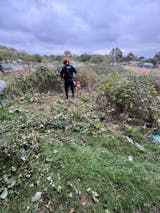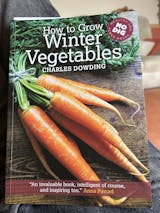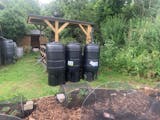Advice on how to take your first steps
Here I give advice that may be applicable to your situation – take the bits that work for you. Every site is different, and every gardener has different needs, abilities and resources.

Starting a new allotment with weeds
The photo above is of Emma Kane’s new do dig allotment in North Cadbury, Somerset – mid-April 2022. Just three weeks earlier, this plot had been a mass of weeds.
She and her husband laid cardboard over the whole area and then compost on beds, and old wood chip on paths. The compost was mostly from a pile of really old wood chip.
Clearing
Starting a new allotment with weeds is normal, and allotments can be big, too big for most people to dig over and clear in a weekend.
However, weeds can be cleared through mulching, and you can mulch any-sized area quickly, with cardboard or polythene. The key point is to starve weeds of light.
Starting with perennial weeds
If your space is very overgrown, it could be mowed or scythed, and then covered with black polythene or old wool carpet. Cardboard can be used but will decompose before perennial weeds such as couch grass, docks, dandelions and buttercup are dead, so it would need renewing every 2 months or so, depending how thick it is. When used for clearing ground, cardboard is best weighed down with a few stones or poles around its edges.
Perennial weeds that are mulched take different lengths of time to die off, according to how much food and energy they have stored in their roots. The following lengths of time give you an idea of how long it would take, in complete darkness: buttercup, 2-3 months; dandelions and stinging nettles, 4 months; ground elder, 12 months; couch grass, 9-15 months; bindweed and marestail, 18 months plus. These are approximate numbers – times can be less in summer and more in winter.
Starting with annual weeds
If you are faced with only annual weeds (bliss!), cardboard is still useful as the first layer of a weed-free mulch, with 7–10 cm/3–4 in compost on top, which can be sown or planted into straight away.
For more information on dealing with weeds, see this page.
See also my video, with tips for clearing weeds without digging.
Making beds – compost
With clean soil, you can make beds of any size by simply putting compost or well rotted manure on top.
Which compost or manure? I can’t advise for every situation. Sometimes municipalities sell ‘green waste compost’, but sometimes not. There may be a local stables but you’d need to find a car (or tractor) and trailer to bring in enough manure, preferably dark and well rotted.
Organic farmers don’t usually sell manure – they need it all and value it too highly – and there have been problems with contaminated manure from horse manure. It has been realised, too late, that some animal dung contains herbicide from their diet of treated grass or hay. It’s worth asking questions of your source like, ‘Was the feed grass sprayed with aminopyralid herbicide?’ It is mostly horse manure that has this problem, because horse owners like clean hay.
For more information on compost, including making your own, see this page.
Making beds – sides
Beds with compost on are often bordered with wood of 15 cm/6 in width, but this is not obligatory. Enclosed beds are clearly defined and look neater, but their edges can dry out more in summer than unbordered beds where compost is allowed to spill slightly into pathways. The compost is not wasted because roots feed into paths and also use them as a moisture resource.
A further issue with wooden sides is that they tend to harbour slugs and woodlice, especially as they begin to age and decay. You can save money and trouble by not using them, but paths then need to be more weed-free, so that weeds don’t spread into beds.
Paths
These need to be weed-free, as much as the beds. I use cardboard to mulch paths for 6–9 months, enough time to kill most weeds. You then need to put more cardboard on top every 3 months, before weeds start growing through the older, decaying cardboard.
This process of mulching paths to clear weeds is easier if you remove any old wooden sides before starting.
For more information on dealing with weeds, see this page.
Path characteristics
- They are permanent, in the same place every year.
- Mulched soil in paths maintains structure, fertility and moisture, available to plant roots from the bed edges.
- They are not just ‘ground to walk on’, but part of your growing space.
Path mulches
Think of mulches as feed for the soil, as well as for suppressing weed growth. When soil is undisturbed and its inhabitants are well fed, fewer weeds grow, so the two go together.
- This is one reason I don’t recommend path mulches of membrane or polythene, which add nothing to soil fertility unless you lift them annually to spread an organic mulch.
- The other reason is soil pollution – read on.
Beware the tendency for mulches of any kind of plastic to disappear below surface level. It seems impossible at first sight for this to happen, but I frequently hear stories of people taking on new allotments in the UK, then discovering synthetic carpet, plastic and membranes buried and out of sight. Once some soil, or compost and weeds, land on them, nature quickly colonises the surface. Such buried materials are impermeable, both to the roots of our plants and to larger organisms in the soil, and are therefore a general hindrance to growth. Plus they are a pollutant in the case of non-wool carpets, i.e. 99%+ of carpets available.
- Cardboard is not pollutant-free, but I have not observed problems to worms and plantings from using it just occasionally. In the case of path mulches, one to three layers of cardboard serves to kill most weeds, and this is only necessary in year one, if there are lots of weeds to clear.
I like to use woody mulches on paths, where practical. When beds have no sides, don’t overdo the depth of woody mulch, to prevent a lot of it ending up on your beds. A little is fine, more if the wood is half or more decomposed.
Timings – when to start planting
If your compost is soft and even, you can sow or plant straight away. Otherwise it works well to make beds a month before starting to sow or plant, so that a little weathering can happen, and perhaps a first flush of weeds can be hoed off or hand-weeded.
Is it your first time growing vegetables? If so, take a good look around at how neighbours are doing, and what crops are growing well. Be prepared for some failures until you have enough experience to appreciate what works for you.
Maintenance, easier than starting a new allotment with weeds
5–15 cm/2–6 in of compost is the one-off, initial application. Once a no dig system is up and running, with perennial weeds gone and only vegetables growing, the annual application of organic matter is no greater than that of any other well run garden, about 2.5 cm/1 in per year.
- Compost is for keeping soil alive and healthy, as well as for bringing nutrients.
- All the soil fauna and fungi that are not damaged by digging can become more abundant and help plants to grow more healthily.
Putting compost/composted manure on top serves to create, over time, a soil that is well structured but firm, free draining but also moisture retentive, and darker on top, with a superficial tilth that can be sown or planted into. This approach works well even for carrots and parsnips, crops that are supposed to fork when compost or manure has been added. Potatoes need loose compost or soil, but only near the surface for their tubers to swell, and ‘earthing-up’ with compost replicates this.
It is a fair job to mulch and set up a clean, no dig plot, but by the end of a year you should find gardening becomes more enjoyable and creative, with less of the routine weeding, above all. Just do not allow any of the (smaller) number of weeds to go to seed!
Allan Cavill, South West Mentor of the National Allotment Association, says that no dig allotments stand out for their fewer weeds and healthy plants; he is surprised there is not more take up of no dig on allotments.
Claire Lassman, a biologist from Frome in Somerset, wrote in June 2016, ‘On the allotment site where I have a plot, it is easy to tell those who use no dig because the veg they grow is so vibrant.’
The information above is available to download as a PDF.
A site for allotment holders!
Allotment Online is an online platform for growers to find useful information, enter competitions, and share experiences and knowledge with like-minded growers through a live blog. Visitors to the site are currently being offered 10% off three of my books: No Dig, Skills for Growing and Vegetable Garden Diary.
Here are two stories of allotments that have been converted to no dig
Bastiaan Koekkoek’s allotment in South East London
Bastiaan had experience of growing veg on allotments in The Netherlands (where he is from) though did not know about no dig at that time, so every year he was digging up Frisian clay which was painstakingly heavy!
After discovering no dig on YouTube, he was determined to give it a go, and decided to make some changes to the allotment space he shared with his neighbour in London.
He started in September 2022, removing all the old structures, masses of weeds, and many slug/snail hiding places.





He added a small greenhouse for the winter to grow salads in, and started creating the first no dig beds shortly after that, working his way from left to right on the plot. He ordered two pallets of mushroom compost which he used to help create the beds, and is lucky to have a steady supply of wood chips which he used to create the paths.












By early April 2023, Bastiaan had finished all the major groundworks and removed all the rubbish which had been left by other plot holders, and had started putting plants in the ground, including some overwintering cabbages, spinach and rocket.


He also built three big compost bins where he sieved any soil that was taken away to make the plot more level. He had a good supply left over (weed root-free) to use later in the year (if he decides to top the beds up with that, instead of the free green waste compost they get delivered). The other compost bins are full of horse manure, which reached a healthy temperature of 70°C/158°F, breaking down well.


Later in spring, he also planted broad beans, onions, salads, curly kale, cavolo nero, strawberries, carrots, fennel, beetroot and more, which all grew well. There was asparagus in the ground too, left over from before the ‘renovations’.


By June 2023, Bastiaan and his neighbour had harvested salads, cavolo nero, kale, cabbages and lots more from the allotment. He said that the taste, quality and nutritional values were off the chart! Courgettes, sweet passion melon, tomatoes, aubergines and peppers were growing nicely in the greenhouse and there were some outside as well. They’d also started planting purple sprouting broccoli for next spring and were starting to harvest broad beans, which had grown amazingly well (some had black aphids but that was remedied by hosing them off).
Photos from 17th June 2023, just nine months after starting work on the allotment – fantastic results.











Robin Baxter’s allotment, reclaimed and run without digging
Here are some pictures of Robin Baxter’s no dig allotment in Ilkeston, Derbyshire, which he took over in a dire state, just after visiting Lower Farm in 2008. The images are testament to his commitment, and to the fact that he is no stranger to hard graft where it is needed, mostly at the beginning stages. The plot is now clean and fertile, and needs much less input of time – he grows a lot of delicious food there.











Robin is now Master Gardener for Garden Organic in Rye Prison near Coventry, running a hugely successful programme, helping prisoners through their involvement in creating a beautiful garden, on Ministry of Defence lack-of-soil! Robin’s work is receiving much acclaim from university researchers.












































